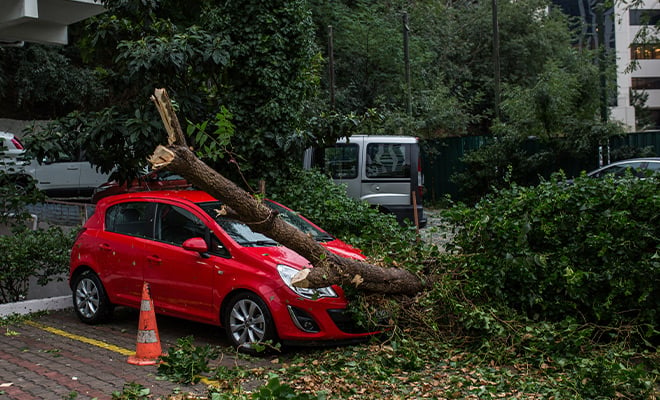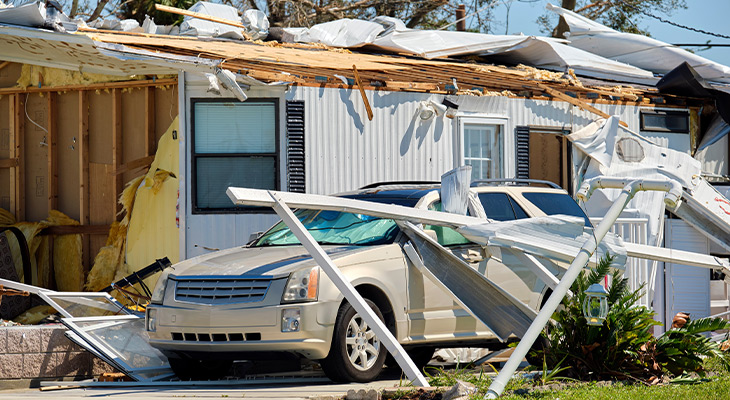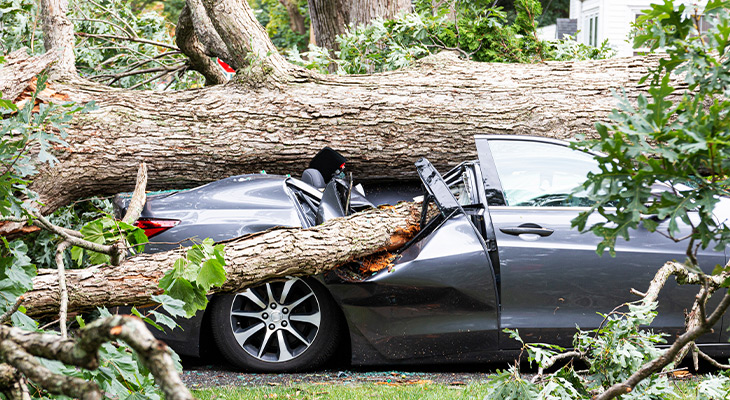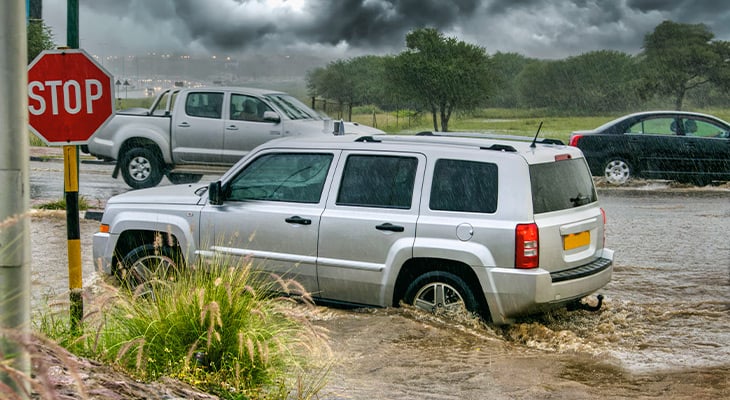Hurricane Damage and Car Insurance: What’s Covered and How It Works
At Compare.com, it’s our mission to find simple ways to help our customers save money on the things they need. While we partner with some of the companies and brands we talk about in our articles, all of our content is written and reviewed by our independent editorial team and never influenced by our partnerships. Learn about how we make money, review our editorial standards, and reference our data methodology to learn more about why you can trust Compare.com.
Hurricanes are the deadliest and most costly natural disasters in the United States. The devastating wind, storm surge, and flooding that a hurricane produces can be life-threatening and cause extensive damage to your car. But without comprehensive coverage on your auto insurance policy, your vehicle won’t be covered for hurricane damage.
The Atlantic hurricane season on the East and Gulf Coasts starts on June 1 and ends on November 30, according to the National Hurricane Center. If you live along the coast and potentially in the path of a natural disaster like a hurricane, you’ll want the best auto coverage to protect your vehicle.
Keep reading to learn how your policy can cover hurricane damage.
Get Cheaper Coverage in Minutes
Does Car Insurance Cover Hurricane Damage?
Comprehensive insurance can cover the cost of hurricane damage resulting from tropical storms, strong winds, heavy rains, flood damage, and falling objects like a tree branch crashing into your vehicle.
If you’re driving and your car is damaged by another car or something on the road during the storm, collision coverage can pay to fix or replace it.
Even though most states require you to have liability insurance, it won’t cover your own vehicle damage. But bodily injury liability and property damage liability cover others’ injuries and property damage if you cause an accident.
If you don’t have the right coverage for hurricane damage on your policy, you should know when to buy it. If you wait too long, it could be too late.
When should you buy hurricane coverage?
If you live in a hurricane-prone area, you’re probably no stranger to seeing a tropical storm warning issued. You should buy comprehensive coverage well before a hurricane is on the horizon.
When severe weather is in the forecast, insurance companies may issue something called a binding suspension (also called a moratorium) on specific activities. This means if a warning or watch gets issued for your area, your insurance company may not allow you to buy a new car insurance policy, make changes to your existing coverage, or add new coverage.
Though optional, it’s a good idea to have this coverage year-round. Comprehensive car insurance covers more than just weather-related damage. It also covers non-collision events like theft, vandalism, a broken window or windshield, and animal damage.
Is It Worth It to File a Hurricane Damage Claim?
You should consider the extent of your vehicle damage and comprehensive deductible when determining whether to file a hurricane damage claim. For example, if your car has minor damage costing $1,000 to fix and you have a $500 or $1,000 deductible, it’s probably not worth it. In situations like these, you’ll save more in the long run if you pay for the repairs yourself.
But if you have significant motor vehicle damage, it can be worth it to file a claim. Your insurance company pays up to your car’s actual cash value (ACV) minus your deductible.
Keep in mind that any claim you file could cause a rate increase. Insurers consider how many claims you’ve filed recently, the types of claims, and claim costs when renewing your policy. Weighing the pros and cons of filing a claim can help determine if it’s the right choice.
Next, we walk you through how to file a claim.
How to File an Auto Insurance Claim for Hurricane Damage
If your car has been damaged in a hurricane, filing a claim with your car insurance company is as easy as these five steps:
- Gather information: Inspect your vehicle for damage once it’s safe and the storm is over. Take photos of the damage and have your policy number available for the next step.
- File the claim: Log into your insurance company’s website or mobile app, visit your agent, or call your insurer to start the claims process. Use the information you gathered to complete the claims form.
- Work with the insurance adjuster: After the insurer assigns an adjuster, they’ll review the claim information and complete a damage inspection. The adjuster may ask you for more information and request a repair shop estimate to determine the insurance payout.
- Settle and fix your vehicle: Once you come to a settlement agreement with the insurance adjuster, you’ll receive your payment to repair or replace your car.
- Review your policy: Your premium may change after your claim is closed. Rate increases are a good reason to shop and compare auto insurance quotes to see if you’re getting the best price.
Compare Quotes from America’s Top Insurers
How Much Does It Cost to Repair Hurricane Damage?
Car insurance claims for storm damage can be expensive, especially if floodwaters damage your vehicle. Depending on your vehicle’s value and repair price, your insurer could declare your car totaled and not worth fixing. The cost of repairs depends on several factors, such as:
- Severity and type of storm damage
- Your insurance policy coverage and deductible
- Total cost of repairs for your damaged car
State Farm paid around $1.2 billion after three hurricanes in nine states in 2021, and approximately 25% of named storm claims were for vehicles. Louisiana, New York, New Jersey, Pennsylvania, and Maryland were the top states for auto and home claims.
The top five states with the most hurricane events are:
- Florida
- Texas
- Louisiana
- North Carolina
- South Carolina
So if you live in one of these states, consider adding comprehensive insurance to your auto policy if you don’t already have it.
How Much Does Comprehensive Insurance Cost?
Drivers pay an average of $174 monthly for comprehensive auto insurance, according to National Association of Insurance Commissioners (NAIC) data. Things like weather events, vehicle theft rates, your ZIP code, and vehicle repair costs factor into how much you pay for comprehensive coverage.
The table below shows the average comprehensive premium by state.
| State | Average Comprehensive Premium |
|---|---|
| Alabama | $186 |
| Alaska | $156 |
| Arizona | $209 |
| Arkansas | $245 |
| California | $97 |
| Colorado | $312 |
| Connecticut | $139 |
| Delaware | $140 |
| Florida | $224 |
| Georgia | $156 |
| Hawaii | $183 |
| Idaho | $107 |
| Illinois | $145 |
| Indiana | $147 |
| Iowa | $140 |
| Kansas | $231 |
| Kentucky | $283 |
| Louisiana | $169 |
| Maine | $254 |
| Maryland | $123 |
| Massachusetts | $171 |
| Michigan | $150 |
| Minnesota | $168 |
| Mississippi | $217 |
| Missouri | $246 |
| Montana | $223 |
| Nebraska | $310 |
| Nevada | $269 |
| New Hampshire | $116 |
| New Jersey | $122 |
| New Mexico | $132 |
| New York | $220 |
| North Carolina | $177 |
| North Dakota | $155 |
| Ohio | $260 |
| Oklahoma | $134 |
| Oregon | $268 |
| Pennsylvania | $109 |
| Rhode Island | $174 |
| South Carolina | $149 |
| South Dakota | $217 |
| Tennessee | $353 |
| Texas | $173 |
| Utah | $279 |
| Vermont | $126 |
| Virginia | $155 |
| Washington | $149 |
| Washington, D.C. | $121 |
| West Virginia | $227 |
| Wisconsin | $170 |
| Wyoming | $352 |
| National average | $174 |
Comprehensive coverage is the least expensive in California and Idaho. These states have less severe weather and non-collision events compared to Tennessee and Wyoming, the states with the highest average comprehensive premiums.
Find the Best Comprehensive Rates in Minutes
FAQs About Hurricane Damage
The best way to protect your vehicle is to have the right coverage in place before a hurricane happens. Here are answers to the most common questions people ask about hurricane damage and car insurance.
What is a hurricane moratorium?
A hurricane moratorium is when an insurer temporarily stops allowing policy changes or issuing new insurance products, usually after a tropical storm watch or hurricane warning has been issued. You can contact your car insurance company or insurance agent if you’re unsure if a hurricane moratorium will affect you.
Do you have to pay a deductible for hurricane damage to your car?
Yes. If you have a comprehensive coverage deductible, you’ll have to pay that amount out of pocket if you file a claim for hurricane damage. For example, if your vehicle damage totals $4,000 and you have a $500 comprehensive deductible, you’ll pay the repair shop $500, and your auto insurance company pays $3,500.
Will a hurricane damage claim cause your insurance to go up?
It’s possible. Any claim you make against your car insurance policy can cause your rates to go up, even comprehensive claims. Speaking with your insurance agent before filing a claim to see how it would affect your premium may be a good idea.
Can insurance drop you after a hurricane?
Insurance companies may drop people after a hurricane, especially drivers who’ve filed multiple claims in recent years. Some states may put a moratorium, or ban, on this type of activity after major hurricanes and other extreme weather events. For example, Florida issued a 60-day ban on canceling or non-renewing policies in affected areas after Hurricane Ian.
What happens if your car gets destroyed in a hurricane?
If your car is destroyed in a hurricane, you can file a comprehensive claim with your insurer. If your insurance company determines that your vehicle is totaled, the company will pay you the value of your vehicle minus your deductible. But if you have only liability coverage, your insurance policy won’t be responsible for anything and you won’t receive a payout.
Methodology
Data scientists at Compare.com analyzed more than 50 million real-time auto insurance rates from more than 75 partner insurance providers in order to compile the quotes and statistics seen in this article. Compare.com’s auto insurance data includes coverage analysis and details on drivers’ vehicles, driving records, insurance histories, and demographic information.
All the quotes listed in this article have been gathered from a combination of real Compare.com quotes and external insurance rate data gathered in collaboration with Quadrant Information Services. Compare.com uses these observations to provide drivers with insight into how auto insurance companies determine their premiums.
Sources
- National Association of Insurance Commissioners, “2019/2020 Auto Insurance Database Report,” Accessed February 11, 2024.
- National Hurricane Center, “Hurricane Season,” Accessed February 11, 2024.
- World Population Review, “Hurricanes by State 2024,” Accessed February 11, 2024.
Compare Car Insurance Quotes
About Compare.com
Compare.com’s #1 goal is to save you money. We publish resources that are based on hard-hitting data and years of industry experience to help you make more informed decisions with your wallet.
- All of Compare.com’s content is written and reviewed for accuracy by a team of experienced writers and editors who are experts on the topics they cover.
- None of Compare.com’s content is ever influenced by the companies and brands we partner with.
- Compare.com’s editorial team operates independently of any of the company’s partnership or business development interests. We publish unbiased information strictly for the benefit of our readers.
- All of the content you see on Compare.com is based on comprehensive analysis and all data is gathered and vetted from trustworthy sources.
Learn more about us, our team, and what makes us tick.








